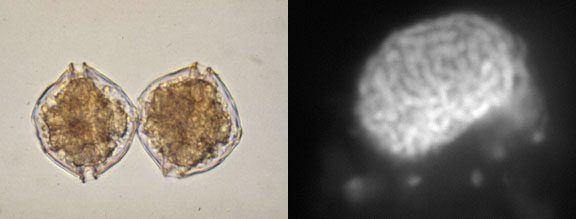En-Gen: Gene expression and harmful algal bloom dynamics
Lead PI: J. Hackett, University of Arizona. Co-PIs: D.M. Anderson (WHOI), D. Bhattacharya (U. of Iowa), and D.L. Erdner (University of Texas)
The overall goal of this project is to identify the key cellular processes involved in harmful algal blooms (HABs), commonly called “red tides”. HABs pose a major threat to human health, ecosystem health, and fisheries resources throughout the world. Our model system is the toxic dinoflagellate Alexandrium tamarense, a unicellular alga that produces saxitoxins, the neurotoxins that cause paralytic shellfish poisoning, the most widespread of all HAB poisoning syndromes. With the recent development genomic resources for A. tamarense, it is now possible to conduct studies of environmental regulation of gene expression in this important species and to begin to unravel the mysteries of bloom dynamics and cellular metabolism at a level that has never before been possible. We propose to identify transcriptionally regulated genes and pathways during the three general stages of a bloom: initiation, development, and termination. Specifically, we propose to create a microarray for A. tamarense to:
• Identify the key genes involved in the initiation of A. tamarense blooms, specifically those regulated during the germination of resting cyst life stages;
• Identify the key genes involved in the development and maintenance of A. tamarense blooms, specifically those involved in the assimilation of organic and inorganic nutrients, the process of photosynthesis, the production of toxins, and the cell division cycle;
• Identify the key genes involved in the termination of A. tamarense blooms, specifically those regulated in response to nutrient limitation, and during the transition from vegetative growth to the sexual cycle that results in resting stage formation;
• Investigate the physiological state of dinoflagellate cells in situ, by comparing expression profiles of a natural bloom population with the data generated from laboratory cultures. This study is an integrated, collaborative program that relies on expertise in A. tamarense molecular evolution, genomics, physiology, ecology, and toxicity. It will produce a valuable molecular resource for scientists working to understand the ecology and toxicity of A. tamarense and other HAB species and will provide insights into the unique genome of these fascinating, evolutionarily, and economically important, yet understudied protists.
Relevant Publications
Erdner, D.L. and D.M. Anderson. 2006. Global transcriptional profiling of the toxic
dinoflagellate Alexandrium fundyense using Massively Parallel Signature Sequencing.
BMC Genomics 7:88 (1-11).
Hackett, J. D., D. Anderson, D. Erdner, and D. Bhattacharya. 2004a. Dinoflagellates: A
remarkable evolutionary experiment. Amer. J. of Botany 91: 1523-1534.
Hackett, J.D., H.S. Yoon, and D. Bhattacharya. 2006. The genomes of dinoflagellates. In:
Genome Evolution in Eukaryotic Microbes, (Eds.) L.A. Katz and D. Bhattacharya.
Oxford University Press.
